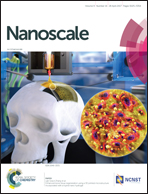Ion selective redox cycling in zero-dimensional nanopore electrode arrays at low ionic strength†
Abstract
Surface charge characteristics and the electrical double layer (EDL) effect govern the transport of ions into and out of nanopores, producing a permselective concentration polarization, which dominates the electrochemical response of nanoelectrodes in solutions of low ionic strength. In this study, highly ordered, zero-dimensional nanopore electrode arrays (NEAs), with each nanopore presenting a pair of recessed electrodes, were fabricated to couple EDL effects with redox cycling, thereby achieving electrochemical detection with improved sensitivity and selectivity. These NEAs exhibit current amplification as high as 55-fold due to the redox cycling effect, which can be further increased by ∼500-fold upon the removal of the supporting electrolyte. The effect of nanopore geometry, which is a key factor determining the magnitude of the EDL effect, is fully characterized, as is the effect of the magnitude and sign of the charge of the redox-active species. The observed changes in limiting current with the concentration of the supporting electrolyte confirm the accumulation of cations and repulsion of anions in NEAs presenting negative surface charge. Exploiting this principle, dopamine was selectively determined in the presence of a 3000-fold excess of ascorbic acid within the NEA.



 Please wait while we load your content...
Please wait while we load your content...